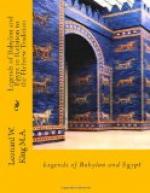Hezekiah’s resistance checked the action of Assyrian influence on Judah for a time. But it was intensified under his son Manasseh, when Judah again became tributary to Assyria, and in the house of the Lord altars were built to all the host of heaven.(1) Towards the close of his long reign Manasseh himself was summoned by Ashur-bani-pal to Babylon.(2) So when in the year 586 B.C. the Jewish exiles came to Babylon they could not have found in its mythology an entirely new and unfamiliar subject. They must have recognized several of its stories as akin to those they had assimilated and now regarded as their own. And this would naturally have inclined them to further study and comparison.
(1) 2 Kings xxi. 5.
(2) Cf. 2 Chron. xxxiii. 11 ff.
The answer I have outlined to this problem is the one that appears to me most probable, but I do not suggest that it is the only possible one that can be given. What I do suggest is that the Hebrews must have gained some acquaintance with the legends of Babylon in pre-exilic times. And it depends on our reading of the evidence into which of the three main periods the beginning of the process may be traced.
So much, then, for the influence of Babylon. We have seen that no similar problem arises with regard to the legends of Egypt. At first sight this may seem strange, for Egypt lay nearer than Babylon to Palestine, and political and commercial intercourse was at least as close. We have already noted how Egypt influenced Semitic art, and how she offered an ideal, on the material side of her existence, which was readily adopted by her smaller neighbours. Moreover, the Joseph traditions in Genesis give a remarkably accurate picture of ancient Egyptian life; and even the Egyptian proper names embedded in that narrative may be paralleled with native Egyptian names than that to which the traditions refer. Why then is it that the actual myths and legends of Egypt concerning the origin of the world and its civilization should have failed to impress the Hebrew mind, which, on the other hand, was so responsive to those of Babylon?
One obvious answer would be, that it was Nebuchadnezzar II, and not Necho, who carried the Jews captive. And we may readily admit that the Captivity must have tended to perpetuate and intensify the effects of any Babylonian influence that may have previously been felt. But I think there is a wider and in that sense a better answer than that.
I do not propose to embark at this late hour on what ethnologists know as the “Hamitic” problem. But it is a fact that many striking parallels to Egyptian religious belief and practice have been traced among races of the Sudan and East Africa. These are perhaps in part to be explained as the result of contact and cultural inheritance. But at the same time they are evidence of an African, but non-Negroid, substratum in the religion of ancient Egypt. In spite of his proto-Semitic strain, the ancient Egyptian himself never became a Semite. The Nile Valley, at any rate until the Moslem conquest, was stronger than its invaders; it received and moulded them to its own ideal. This quality was shared in some degree by the Euphrates Valley. But Babylonia was not endowed with Egypt’s isolation; she was always open on the south and west to the Arabian nomad, who at a far earlier period sealed her Semitic type.




